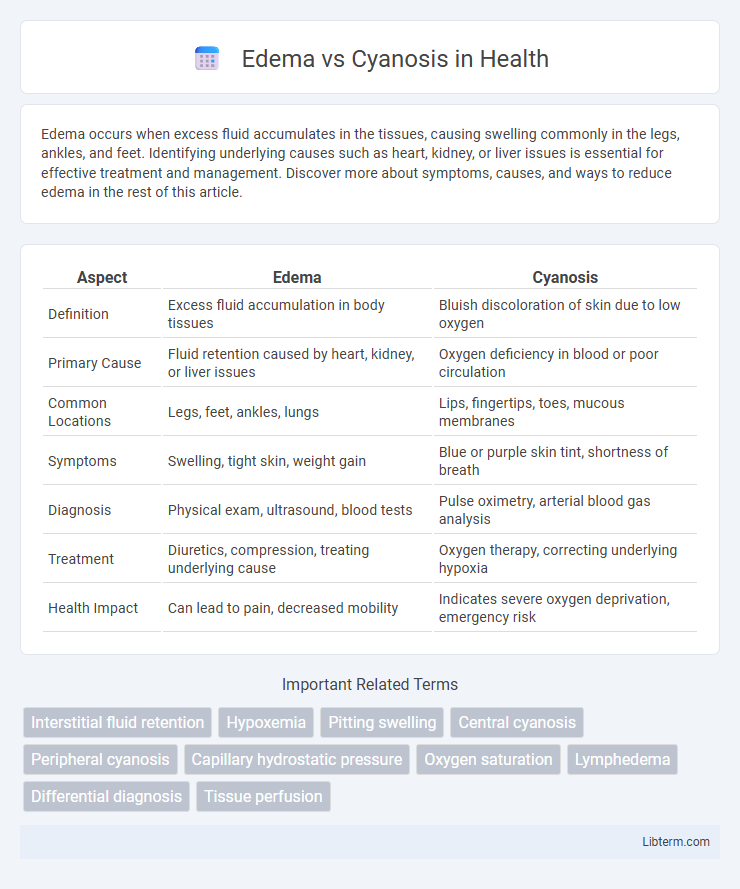Edema occurs when excess fluid accumulates in the tissues, causing swelling commonly in the legs, ankles, and feet. Identifying underlying causes such as heart, kidney, or liver issues is essential for effective treatment and management. Discover more about symptoms, causes, and ways to reduce edema in the rest of this article.
Table of Comparison
| Aspect | Edema | Cyanosis |
|---|---|---|
| Definition | Excess fluid accumulation in body tissues | Bluish discoloration of skin due to low oxygen |
| Primary Cause | Fluid retention caused by heart, kidney, or liver issues | Oxygen deficiency in blood or poor circulation |
| Common Locations | Legs, feet, ankles, lungs | Lips, fingertips, toes, mucous membranes |
| Symptoms | Swelling, tight skin, weight gain | Blue or purple skin tint, shortness of breath |
| Diagnosis | Physical exam, ultrasound, blood tests | Pulse oximetry, arterial blood gas analysis |
| Treatment | Diuretics, compression, treating underlying cause | Oxygen therapy, correcting underlying hypoxia |
| Health Impact | Can lead to pain, decreased mobility | Indicates severe oxygen deprivation, emergency risk |
Understanding Edema: Definition and Causes
Edema is the medical condition characterized by the abnormal accumulation of fluid in the interstitial spaces of tissues, leading to swelling. It commonly occurs due to factors such as heart failure, kidney disease, liver cirrhosis, or localized inflammation affecting capillary permeability and lymphatic drainage. Identifying the underlying cause of edema is crucial for effective treatment and management.
Defining Cyanosis: Signs and Underlying Mechanisms
Cyanosis is a clinical sign characterized by a bluish discoloration of the skin and mucous membranes, indicating reduced oxygen saturation in the blood. It occurs when deoxygenated hemoglobin concentration exceeds 5 g/dL in capillary blood, often due to hypoxemia, impaired oxygen delivery, or abnormal hemoglobin. Key signs include bluish lips, nail beds, and extremities, reflecting localized or systemic oxygen deficiency linked to respiratory, cardiovascular, or hematologic disorders.
Key Differences Between Edema and Cyanosis
Edema is characterized by the abnormal accumulation of fluid in interstitial spaces, leading to swelling primarily in the limbs and tissues. Cyanosis involves a bluish discoloration of the skin and mucous membranes caused by insufficient oxygenation of hemoglobin in the blood. Key differences include edema's presentation as swelling and its association with fluid retention, whereas cyanosis indicates hypoxemia and oxygen deprivation at the tissue level.
Common Symptoms: How Edema and Cyanosis Present
Edema commonly presents with swelling in the affected tissues, often in the legs, ankles, and feet, accompanied by a feeling of heaviness or tightness. Cyanosis is characterized by a bluish or purplish discoloration of the skin and mucous membranes, primarily visible in the lips, fingertips, and nail beds due to insufficient oxygen in the blood. Both conditions signal underlying circulatory or respiratory issues but manifest with distinct visual and tactile symptoms.
Risk Factors Associated with Edema and Cyanosis
Risk factors associated with edema include heart failure, kidney disease, liver cirrhosis, and prolonged immobility, all of which cause fluid retention and impaired circulation. Cyanosis risk factors involve conditions leading to inadequate oxygenation of the blood, such as chronic obstructive pulmonary disease (COPD), congenital heart defects, and severe respiratory infections. Both conditions indicate underlying systemic issues requiring prompt medical evaluation to prevent further complications.
Diagnostic Approaches: Edema vs Cyanosis
Diagnostic approaches for edema primarily involve physical examination for swelling, measurement of limb circumference, and imaging techniques such as ultrasound to detect fluid accumulation in tissues. Cyanosis diagnosis focuses on assessing skin and mucous membrane color changes, pulse oximetry to measure oxygen saturation, and arterial blood gas analysis to evaluate hypoxemia. Differentiating edema from cyanosis relies on identifying underlying causes through laboratory tests, cardiac and respiratory evaluations, and patient history regarding cardiovascular or respiratory disorders.
Edema: Treatment and Management Strategies
Edema treatment primarily involves addressing the underlying cause, such as heart failure, chronic kidney disease, or venous insufficiency, through medications like diuretics to reduce fluid retention and lifestyle modifications including low-sodium diets and compression therapy. Elevating the affected limbs and maintaining physical activity improve lymphatic drainage and reduce swelling. In severe cases, medical interventions such as drainage or surgery may be necessary to manage persistent or complicated edema effectively.
Cyanosis: Medical Interventions and Care Options
Cyanosis requires immediate medical interventions such as oxygen therapy, administration of vasodilators, and addressing underlying causes like cardiopulmonary disorders. Continuous monitoring of blood oxygen levels through pulse oximetry and arterial blood gas analysis is essential for effective management. Care options include maintaining airway patency, providing supplemental oxygen, and managing conditions like chronic obstructive pulmonary disease or congenital heart defects contributing to cyanotic presentations.
Preventing Edema and Cyanosis: Health Tips
Preventing edema involves maintaining proper fluid balance through regular exercise, reducing salt intake, and elevating the legs to promote circulation. Avoiding cyanosis requires ensuring sufficient oxygen delivery by managing underlying respiratory or cardiovascular conditions and avoiding cold exposure. Both conditions benefit from a healthy lifestyle including balanced nutrition, hydration, and regular medical check-ups to detect early symptoms.
When to Seek Medical Help: Edema vs Cyanosis
Seek medical help for edema if swelling is sudden, accompanied by chest pain, shortness of breath, or if it affects only one limb, indicating possible blood clot or heart issues. Cyanosis requires immediate emergency care if you notice blue or purple discoloration of the skin, lips, or nails, especially with difficulty breathing, cold extremities, or fatigue. Prompt medical evaluation is critical for both conditions to prevent complications related to cardiovascular or respiratory problems.
Edema Infographic

 libterm.com
libterm.com